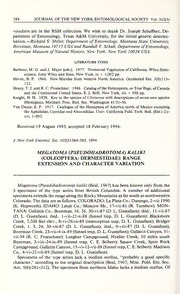
Megatoma (Pseudohadrotoma) kaliki (Coleoptera: Dermestidae): Range Extension and Character Variation PDF
Preview Megatoma (Pseudohadrotoma) kaliki (Coleoptera: Dermestidae): Range Extension and Character Variation
384 JOURNAL OFTHE NEWYORKENTOMOLOGICALSOCIETY Yol. 102(3) vouchers are in the RSM collection. We wish to thank Dr. Joseph Schaffner, De- A&M partment of Entomology, Texas University, for the initial generic determi- nation.—RichardS. Miller, Department ofEntomology, Montana State University, Bozeman, Montana 59715 USA andRandall T. Schuh, DepartmentofEntomology, American Museum ofNaturalHistory, New York, New York 10024 USA. LITERATURE CITED Barbour, M. G. andJ. Major(eds.). 1977. TerrestrialVegetation ofCalifornia. Wiley-Inter- science, John Wileyand Sons, New York, ix + 1,002 pp. Bliven, B. P. 1966. New Miridae from western North America. Occidental Ent. 1(9):115— 122 . Henry,T.J.andR.C.Froeschner. 1988. CatalogoftheHeteroptera,orTrueBugs,ofCanada and the ContinentalUnited States. E. J. Brill, New York, xix + 958 pp. Knight, H. H. 1928. Keyto the species ofClivinema with descriptionsofseven new species (Hemiptera, Miridae). Proc. Biol. Soc. Washington 41:31-36. Van Duzee, E. P. 1917. Catalogue ofthe Hemiptera ofAmerica north ofMexico excepting theAphididae,CoccidaeandAleurodidae. Univ. CaliforniaPubl. Tech. Bull. (Ent.)2:i- xvi, 1-902. Received 19 August 1993; accepted 18 February 1994. J. New YorkEntomol. Soc. 102(3):384-385, 1994 MEGATOMA PSEUDOHADROTOMA KALIKI ( ) (COLEOPTERA: DERMESTIDAE): RANGE EXTENSION AND CHARACTER VARIATION Megatoma Pseudohadrotoma kaliki (Beal, 1967) has been known only from the ( ) 3 specimens of the type series from British Columbia. A number of additional specimensextendstherangealongtheRockyMountainsasfarsouthassouthwestern Colorado. Thedataare asfollows. COLORADO: La PlataCo.: Durango, 2-vii-1990 (K. Hepworth). IDAHO: Latah Co.: Moscow Mt., 17-vii-81 (R. Tumbow). MON- TANA: Gallatin Co.: Bozeman, 16, 26, 30-vi-87 (D. L. Gustafson); ibid., 1 l-vii-87 (D. L. Gustafson), ibid., l-vii-21-x-88 (funnel trap, D. L. Gustafson); Blackmore Creek, 7,200 feet elev., 8-vi-26-ix-89 (interception trap, D. L. Gustafson); Bridger Creek, 1, 3, 24, 30-vii-87 (D. L. Gustafson); ibid., 9-viii-87 (D. L. Gustafson); BozemanCreek, 23-vii-4-ix-89 (funneltrap, D. L. Gustafson); GallatinCanyon, 31- vii-54 (R. C. Froeschner); Langhor Campground, Hyalite Creek, 10 miles south Bozeman, 3-viii-24-ix-89 (funnel trap, C. E. Seibert); Squaw Creek, Spire Rock Campground,GallatinCanyon, 15-vi-12-vii-88(funneltrap,C. E. Seibert). Madison Co., 4-vi-22-vii-89 (funnel trap, D. L. Gustafson). Specimens of the type series lack a median ocellus, “probably a good specific character,” according to the original description (Beal, 1967, Misc. Publ. Ent. Soc. Am. 5(6):281—312). The specimen from northern Idaho lacks a median ocellus. Of 1994 NOTES ANDCOMMENTS 385 the 26 Montana specimens from adjacent Madison and Gallatin counties, 4 lack a median ocellus, 6 possess a reduced ocellus, and 16 have a fully developed ocellus. Four females taken from Durango, La Plata Co., Colorado, have a median ocellus. A specimen from Evergreen, Jefferson Co., Colorado, which I tentatively assigned toP. perversa (Fall)because it possessesa median ocellus (Beal, 1967, op. cit.), most certainly also belongs to this species. In other respects specimens ofthe species fall within the range of variation described for the type series, except that lengths of females vary from 2.7 to 4.0 mm, and the ratio ofwidth (across humeri) to length (ofpronotum and elytra) offemales varies from 1:2.14 to 1:2.35. The specimens collected in funnel traps were taken in unbaited Lindgren traps (Michael Ivie, pers. comm.). The Durango, Colorado, specimens were taken in a home.—R. S. Beal, Jr., 1094 Pine County Court, Prescott, Arizona 86303. ACKNOWLEDGMENT I thank Catherine Seibert and Adam Slipinski ofMontana State University, Boris C. Kon- dratieffofColorado StateUniversity, and Robert H. Tumbow, Jr., ofFort Rucker, Alabama, forthe opportunityto examine the above specimens. Received 10 November 1992; accepted 2 June 1993. J. New YorkEntomol. Soc. 102(3):385-386, 1994 A SOUTHERN DISTRIBUTION FOR THE INTRODUCED DUNG BEETLE APHODIUS OTOPHORUS) ( HAEMORRHOIDALIS (L., 1758) Aphodius haemorrhoidalis is a bovine dung specialist species which frequently occurs in north and south European grasslands (Dellacasa, 1983; Hanski, 1991; LumaretandKirk, 1991). ItisoneamongmanyotherEuropeanspeciesaccidentally introducedinNorth America(Blume, 1985). In thiscontinentitiscommonlyfound in the fieldin dense populations (Kessler and Balsbaugh, 1972; Merrit, 1974; Mohr, 1943). In 1915 Schaeffer reported A. haemorrhoidalis for the first time in New Jersey, UnitedStates(in Woodruff, 1973). About 1940 this speciesenlargeditsgeographical range to New York, Nova Scotia, New Brunswick, Quebec, North Carolina, South Carolina and Illinois. In 1960 it was collected in Kentucky and Massachusetts; and in British Columbia and Florida in 1967. This last record is the southernmost and itpossiblyrepresentstheinitialdispersalofthisbeetlesouthward(Woodruff, op. cit). Accordingto Brown (1967) who reported it from British Columbia,A. haemorrhoi- dalis had already spread to the northwest. Recently it has also been reported from Nebraska (Ratcliffe, 1991). On September 29, 1993 we have caught two specimens ofthis species trapping withcowdunginpasturelandsatthestateofDurango(Mexico):ElTapado(Biosphere
